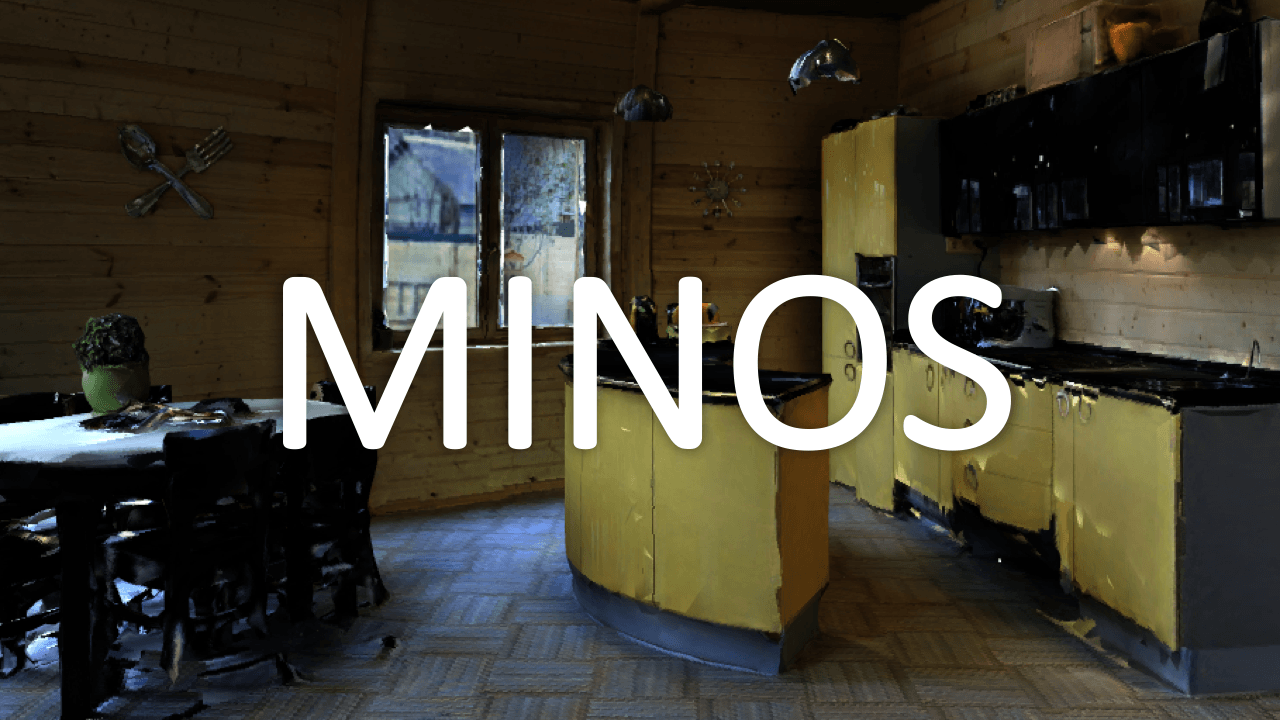MINOS is a simulator designed to support the development of multisensory models for goal-directed navigation in complex indoor environments. MINOS leverages large datasets of complex 3D environments and supports flexible configuration of multimodal sensor suites.
Try our live web client demos!
Use the I/J/K/L keys to step and turn, the arrow keys to strafe and look up or down, the R key to respawn, and the O key to update the agent observations panel on the right. The M key toggles various navigation grid and shortest path visualizations.
-
MINOS can be used on Linux and MacOS systems. Use under Windows is possible but not recommended.
-
Request and download the SUNCG and Matterport3D datasets. Please indicate "use with MINOS simulator" in your request email. For Matterport3D, use the invocation
download_mp.py --task_data minos -o .with the provided download script. This will download a 5.1GB zip archive which expands to approximately 6.3GB. For SUNCG, by default thedownload_suncg.pyscript will download the latest version of the dataset. You can obtain the v1 or v2.0 versions usingdownload_suncg.py --version <version>. -
Install node.js using the Node Version Manager (nvm).
curl -o- https://raw.githubusercontent.com/creationix/nvm/v0.33.7/install.sh | bash source ~/.bashrc nvm install v10.13.0If you use
zshinstead ofbash, replace all instances ofbashwithzsh. Confirm node installation is succesful usingnode -vat the terminal. -
Build the MINOS server modules by running
npm installinside theserverdirectory. This process will download and compile all server module dependencies and might take a few minutes. There are some prerequisites for the build process in Ubuntu, they can be installed usingsudo apt-get install build-essential libxi-dev libglu1-mesa-dev libglew-dev libvips. -
Make sure you have a Python3 installation with pip3 available on your command line. The following steps can be carried out in a virtualenv, or with the system python installation.
-
Install the minos Python module by running
pip3 install -e . -r requirements.txtin the root of the repository. -
Extract the SUNCG and/or MP3D data packages under
$HOME/work/suncgand/or$HOME/work/mp3d, or under another parent directory of your choice. If you choose a directory other than$HOME/workas the dataset parent directory remember to run all remaining commands with the prefixNODE_BASE_URL=path/to/data_parent_dir. -
Check that everything works by running the interactive client through
python3 -m minos.tools.pygame_client, invoked from the root of the repository. You should see a live view which you can control with the W/A/S/D keys and the arrow keys. This client can be configured through various command line arguments. Run with the--helpargument for an overview and try some of these other examples:python3 -m minos.tools.pygame_client --empty_room: navigation in empty SUNCG environmentspython3 -m minos.tools.pygame_client --dataset mp3d --scene_ids 17DRP5sb8fy --env_config pointgoal_mp3d_s: an example Matterport3D environmentpython3 -m minos.tools.pygame_client --agent_config agent_gridworld: discrete navigation agentpython3 -m minos.tools.pygame_client --depth -s normal -s objectId -s objectType -s map --navmap --width 128 --height 128: multimodal agent with depth, normals, object instance and category frames
See the API document for an overview of the Simulator API and a reference of the available configuration parameters. Please also refer to the FAQ document for answers to common questions and resolutions for common errors.
We provide a demo gym wrapper of MINOS in gym/demo.py.
Install by running pip3 install -e . in the gym directory.
Run through python3 demo.py. Various configuration options are available and documented in the --help information.
For example, you can run the room goal task in small Matterport3D environments using:
python3 demo.py --env_config roomgoal_mp3d_s
Or run the object goal (door target) task in medium furnished SUNCG environments using:
python3 demo.py --env_config objectgoal_suncg_mf
- Navigation benchmark scenarios for Matterport3D and SUNCG at https://github.com/minosworld/scenarios
- UNREAL / A3C / A3C-LSTM baselines at https://github.com/minosworld/unreal
- DFP baseline at https://github.com/minosworld/dfp
We provide a collection of scripts that are useful for setting up experiments, benchmarking, and visualizing agent episodes. The scripts provide --help documentation.
-
minos/tools/generate_episodes.py- Presamples agent episodes (start states and goals) and produces a CSV format file that can be used as a parameter to thestates_filetask configuration option. -
minos/server/check_episode_states.js- Checks presampled agent episodes to verify navigability.
minos/server/export_navgrid.js- Exports precomputed navigation maps (will need to be computed and exported for scene sets other than the ones provided in the repo):UseNODE_BASE_URL=~/work ./export_navgrid.js --config_file ../config/visualize_traces.json --output_dir navgrid --ids 004667ffa2594fa780e84d7b979f25ab--arch_onlyor--empty_roomto generate navigation maps for architecture-only and empty room variants.
-
minos/server/visualize_path.js- Visualizes presampled episodes and shortest paths:NODE_BASE_URL=~/work node --max-old-space-size=2048 visualize_path.js --compress_png --config_file config/visualize_traces.json --color beige --output_dir simpath --input ~/code/sim/data/episode_states.test.csv --ids dc251799d2b7cbc1fee86fbf524f2bec --allow_diag false -
minos/server/visualize_traces.js- Visualizes prerecorded action traces.
Benchmarking scripts to test the performance of the simulator:
-
minos/server/benchmark.js- Use to benchmark the javascript server component in standalone mode. -
minos/tools/benchmark.py- Use to benchmark client-server communication through SocketIO. Allows for specification of sceneIds and episodes per scene to go through, various simulator configurations (sensory inputs to enable, rendering options) and for running with multiple simulators.
- 2017-12-11 MINOS beta release!
We are committed to continuously improving MINOS and supporting the research community. We will post a detailed roadmap and contribution guidelines in the near future.
If you use MINOS please cite our technical report:
@article{savva2017minos,
author = {Manolis Savva and Angel X. Chang and Alexey Dosovitskiy and Thomas Funkhouser and Vladlen Koltun},
title = {{MINOS}: Multimodal Indoor Simulator for Navigation in Complex Environments},
journal = {arXiv:1712.03931},
year = {2017}
}
MINOS specific code is distributed under the MIT License.
